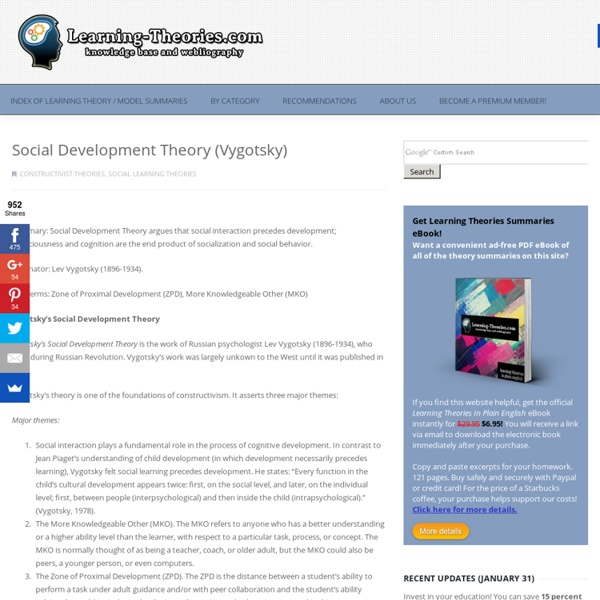Stage Theory of Cognitive Development (Piaget
Summary: Piaget’s Stage Theory of Cognitive Development is a description of cognitive development as four distinct stages in children: sensorimotor, preoperational, concrete, and formal. Originator: Jean Piaget (1896-1980) Key Terms: Sensorimotor, preoperational, concrete, formal, accommodation, assimilation. Piaget’s Stage Theory of Cognitive Development Swiss biologist and psychologist Jean Piaget (1896-1980) observed his children (and their process of making sense of the world around them) and eventually developed a four-stage model of how the mind processes new information encountered. He posited that children progress through 4 stages and that they all do so in the same order. Sensorimotor stage (Birth to 2 years old).
Balancing the Two Faces of E-Portfolios
Printable version of this paper (PDF - 2 MB) Helen C. Barrett Figure 1. Balancing the Two Faces of E-Portfolios Learning Objectives After completing this chapter, you should be able to: · Explain the two major purposes for developing e-portfolios in education · Outline how to balance both process and product to enhance learner engagement with the e-portfolio process · Understand how students’ experiences with social networking can contribute to their engagement with e-portfolio development · Understand the role of intrinsic motivation in the e-portfolio development process · Outline a developmental process to implement e-portfolios through three levels: 1. 2. 3. This chapter focuses on these two major purposes for developing e-portfolios, and how to balance both approaches to enhance learner engagement with the e-portfolio process. U. Technology also gives students opportunities for taking ownership of their learning. Later in the publication, in the section on Assessment: Why E-Portfolios?
Constructivism
Summary: Constructivism as a paradigm or worldview posits that learning is an active, constructive process. The learner is an information constructor. People actively construct or create their own subjective representations of objective reality. New information is linked to to prior knowledge, thus mental representations are subjective. Originators and important contributors: Vygotsky, Piaget, Dewey, Vico, Rorty, Bruner Keywords: Learning as experience, activity and dialogical process; Problem Based Learning (PBL); Anchored instruction; Vygotsky’s Zone of Proximal Development (ZPD); cognitive apprenticeship (scaffolding); inquiry and discovery learning. Constructivism A reaction to didactic approaches such as behaviorism and programmed instruction, constructivism states that learning is an active, contextualized process of constructing knowledge rather than acquiring it. Vygotsky’s social development theory is one of the foundations for constructivism.
An Introduction to Connective Knowledge
Revised and Updated (minor corrections and typos only) and placed in MS-Word Document form, November 27, 2007. Click here. The version that follows below is the original (uncorrected) version). Yet another article, describing new forms of knowledge as probablistic, has crossed my desk today, and consequently it seems appropriate at this time to type a few words on the nature of distributed knowledge. It should go without saying that these are my own thoughts, and this discussion should not therefore be considered an authoritative reference on the subject. a. You probably grew up learning that there are two major types of knowledge: qualitative and quantitative. Distributed knowledge adds a third major category to this domain, knowledge that could be described as connective. This is more than just the existence of a relation between one entity and another; it implies interaction. This is why it is incorrect to represent distributed knowledge merely as a type of probabilistic knowledge.
Cognitivism
Summary: The cognitivist paradigm essentially argues that the “black box” of the mind should be opened and understood. The learner is viewed as an information processor (like a computer). Originators and important contributors: Merrill -Component Display Theory (CDT), Reigeluth (Elaboration Theory), Gagne, Briggs, Wager, Bruner (moving toward cognitive constructivism), Schank (scripts), Scandura (structural learning) Keywords: Schema, schemata, information processing, symbol manipulation, information mapping, mental models Cognitivism The cognitivist revolution replaced behaviorism in 1960s as the dominant paradigm. A response to behaviorism, people are not “programmed animals” that merely respond to environmental stimuli; people are rational beings that require active participation in order to learn, and whose actions are a consequence of thinking.
What do we mean by learner-centred e-learning?
Placing the learner at the centre of the learning process is often encouraged in e-learning design yet frequently misunderstood. I find that the examples provided in articles about this topic repeatedly ignore the real meaning of this approach. If you think adding the following to your e-learning designs make it learner-centred, I’m afraid I have to disagree (this is a snapshot of suggestions offered in numerous articles about the same): Use scenario-based design with 3-4 choices every few screens (some designers say this gives ‘control’ to the learner and is therefore learner-centred – really?) These are all very useful learning design approaches to increase motivation, but they don’t make a course more learner-centred. Jonassen et al. (1995)* (yes, almost 20 years ago!) According to Jonassen there are four distinct attributes of learner-centred effective e-learning courses: Are these elements present in your e-learning? *Jonassen, D., Davidson, M., Collins, M., Campbell, J., & Haag, B.
Vygotsky (1978). Mind in society: The development of higher psychological processes. | Research & Study Notes
Vygotsky, L. S. (1978). Mind in society: The development of higher psychological processes. (M. Cole, V. John-Steiner, S. Table of contents Introduction (Michael Cole and Sylvia Scribner), 1Biographical Note on L. Chapter 1 “Tool and Symbol in Child Development” (pp 19-30) [Discussion about how language development and practical intelligence were seen as developing separately, for example, Piaget identified egocentric speech as though there was no organizing function of the language activity (p 23-24).] [Apes and people with aphasia ...] “Guillaume and Meyerson offer a different conclusion regarding the role of speech in the inception of uniquely human forms of behavior. “Our analysis accords symbolic activity a specific organizing function that penetrates the process of tool use and produces fundamentally new forms of behavior.” [V. describes how language is used to form complex processes, different from direct manipulation as evidenced in apes (p 26)] [Reference to social speech... ]



